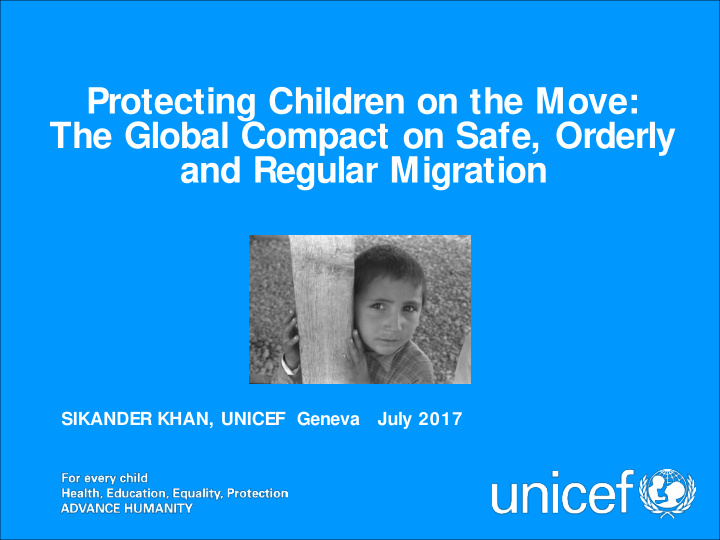



Protecting Children on the Move: The Global Compact on Safe, Orderly and Regular Migration SIKANDER KHAN, UNICEF Geneva July 2017 UNICEF
Children and Migration • Not a new issue for children • Involves large numbers of children and families across regions • Polarizing/political sensitive • At the core of our rights agenda • Various streams of work across the organization • Growing demand to expand UNICEF’s engagement, to increase coherence, establish priorities and guiding principles UNICEF
Refugee/unaccompanied children • In the Middle East of the 4.7 million Syrian refugees, living in communities or in refugee camps, more than half are children (UNHCR 2016) • In the South Sudan crisis almost two thirds of the 660,000 refugees are children (UNHCR 2016) • 39,000 unaccompanied children were apprehended at the US/Mexico Border in fiscal year 2015 (in addition to children travelling with their families) (US Customs and Border Protection 2016) • Over 1 million persons sought asylum in Europe in 2015; the proportion of children among them is increasing to a third or more (UNHCR 2016) UNICEF
UNICEF’s Support on the Ground Technical Assistance on coordination, capacity building & development of protocols Access to Education Rapid Family Tracing Psychosocial support and related services Child friendly spaces Provision of water and sanitation facilities Food and nutrition for young children and babies Provision of information on service points available en-route UNICEF
Existing gaps • Lack of coordination between law enforcement and child protection • Limited cross-over between CRC Standards and public policies which concern migrants and their families. • Balance between Migration Policy and children’s rights, including the child’s right to participate meaningfully in decisions affecting him/her. • Coherent, long-term response to the increasing numbers of children embarking on independent migration. • ‘Guaranteeing’ safe return that is always in the child’s best interests . UNICEF
Moving the agenda forward • Voice (normative role) and engagement • Technical leadership (data, evidence, advice) • Relevant programme response • Clear link between policy asks and programme results • Flexible ways of working: cross-border; across contexts (origin, transit, destination) and sectors • Mainstreaming within existing work (no new “sector”) • Dedicated investment in building capacities • Strong partnerships and presence to influence the Global Compact on Migration UNICEF
ADVOCATING FOR CHILDREN SIX GLOBAL POLICY ASKS FOR CHILDREN 01. PROTECT CHILDREN, PARTICULARLY UNACCOMPANIED CHILDREN, FROM EXPLOITATION AND VIOLENCE 02. END THE DETENTION OF CHILDREN SEEKING REFUGEE STATUS OR MIGRATING 03. KEEP FAMILIES TOGETHER AS THE BEST WAY TO PROTECT CHILDREN AND GIVE CHILDREN LEGAL STATUS 04. KEEP ALL REFUGEE AND MIGRANT CHILDREN LEARNING AND GIVE THEM ACCESS TO HEALTH AND OTHER QUALITY SERVICES 05. PRESS FOR ACTION ON THE UNDERLYING CAUSES OF LARGE- SCALE MOVEMENTS OF REFUGEE AND MIGRANTS 06. PROMOTE MEASURES TO COMBAT XENOPHOBIA, DISCRIMINATION AND MARGINALIZATION IN COUNTRIES OF TRANSIT AND DESTINATION
Thank you UNICEF
Recommend
More recommend